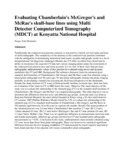Evaluating Chamberlain's McGregor's and McRae's skull-base lines using Multi Detector Computerized Tomography (MDCT) at Kenyatta National Hospital
Abstract
Traditionally the craniocervical junction anatomy is assessed by a lateral cervical spine and base of skull radiographs. The complexity of the anatomy at the craniocervical junction combined with the ambiguities in determining anatomical land marks on plain radiograph, results in a lot of interpretational !nd diagnostic
challenges.Modem day CT offers excellent bony detail and its ability to reconstruct the acquired CT data into various imaging planes make the assessment of the craniocervical junction easy and more accurate. It is in view of these facts that previous radiographic anthropometric values of this junction be evaluated using
newer and accurate modalities like CT and MRI.
Background
The reference distances from the odontoid tip to standard skull baselines of Chamberlain's, Me Gregors and Me Rae's were first obtained using a lateral plain radiograph over 50 years ago. To date plain radiographs remains the prime imaging modality in developing countries for assessing the skull base irrespective of the limitations. Despite the sharp increase of CT scans in Kenyan health facilities in recent days, there has been no evaluation of the same on CT or MRI hence the study.
Objective
The main objective of the study was to evaluate the relationship of the odontoid peg of C2 to the standard skull baselines of Chamberlain's, Me Gregor's and Me Rae's on computed tomography. The other objective was to determine the differences between sexes and different age groups. sectional study was done at Kenyatta National Hospital, the main referral hospital in Kenya using a 16 slice multi detector CT scanner, 2007 Phillips Brilliance Model, Serial No.729, to evaluate the relationship of the odontoid peg of C2 to standard skull baseline of Chamberlain's, Me Gregor's and Me Rae's in 392 patients aged between 16 to 88 years in a period of6 months.
Results
The mean position of the odontoid process was 2.6 mm below Chamberlain's line (median 2.7 mm, SD 2.2 mm), 1.0mm (median 0.9 mm, SD 2.1 mm) below McGregor's line and 4.7 mm (median 4.6 mm, SD 1.3 mm) below McRae's line. There was no significant difference in measurements between male and female participants, different age groups and between CT and standard plain radiographs measurements (p > 0.05).
Conclusion
In this study, anthropometric measurements obtained using CT were lower than those from plain radiographs. There was however no statistical significant difference between the two imaging modalities. CT demonstrated far much superior anatomical bone detail and that of the adjacent soft tissues compared to
plain radiographs.
Publisher
University of Nairobi, Kenya

